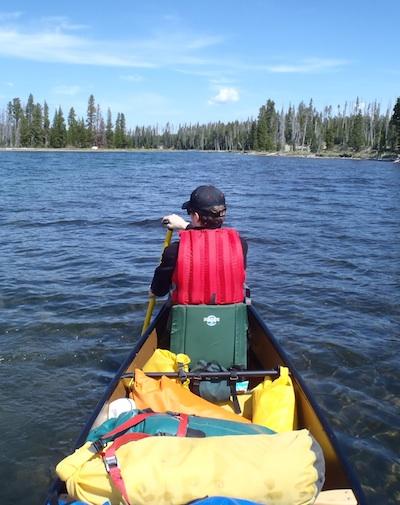
Where in the National Park System should you paddle? Lewis River Channel, Yellowstone National Park. Kurt Repanshek photo.
Just 100 yards away, the thunderous roar of water released from the penstocks at the bottom of the Summersville Dam filled my ears...and left me questioning my sanity. Cloaked in a wetsuit, rain gear, and life jacket, I was a 19-year-old about to shove off on my first-ever whitewater rafting trip down through some of the biggest -- and rockiest -- rapids in the East.
The Gauley River in West Virginia draws whitewater lovers from throughout the east for six weekends each fall, when releases from the dam fuel such punishing rapids as Lost Paddle and Shipwreck. I was a college student eager and anxious to become a paddling guide during my days in the Mountain State, and this was my test run. It launched me into three years as a guide on the Cheat and New rivers in West Virginia, and left me with a lifelong paddling passion that's been sated by trips down the Green, Colorado, Yampa, Middle Fork of the Salmon, and onto many other lakes, streams, and oceans.
But if you weren't as fortunate to have a similar stroke of luck that left you with a passion for water, how would you decide where to paddle in the National Park System? Should you seek a whitewater experience the magnitude of the Gauley River with its Class V-VI rapids? Or are you looking for something requiring less adrenalin, something apropos for a family outing? Do you want to head out onto a lake and into the backcountry of a park? Are you a do-it-yourselfer, or do you want an outfitter to handle all the logistics?
Here are some questions that will help you filter the choices:
* Are you looking for a family outing, a group adventure, or a bonding experience with your teen? Answer that question and you'll quickly winnow the possibilities.

Should you sign on with an outfitter and run the Kennecott River in Wrangell-St. Elias National Park in Alaska? NPS photo.
* How much time do you have? A Colorado River trip through Grand Canyon National Park can take two weeks or longer, while you can paddle for a few hours on the Green or Nolin rivers in Mammoth Cave National Park.
* Where do you live? Today's economics could really narrow your options if you don't have the time or budget to drive or fly across country to float through New River Gorge National River or explore Channel Islands National Park by sea kayak.
* Are you happy being 'motored' down the Colorado on an engine-driven raft carrying 18 people, or are you seeking more of a muscle-powered experience with fewer people?
* Do you want to go on a raft trip, a sea kayak trip, or a canoe trip? Again, answering that question can quickly produce a number of candidate destinations without overwhelming you.
* If you decide to let an outfitter handle the logistics, check up on them. Sometimes endorsements can carry the day, such as the plugs O.A.R.S. has received from National Geographic Adventure and Outside Magazine, the Traveler's own experiences with Holiday River Expeditions, the certifications Channel Islands Outfitters has received over its 20 years of guiding, or the reputation Wilderness River Adventures has built over five decades of river running.

Can you handle outfitting your own trip? Bob Mishak photo.
But don't be afraid to call up a company and ask hard questions. Seek referrals, and ask what their return rate is. Ask them why you should go on one of their trips, as opposed to one offered by a competitor. Ask them what requirements their guides must meet. Are they certified in Wilderness First Aid? Is the company fully and appropriately insured? You might also check with the state licensing agency regarding the company's history, and don't be bashful about calling the National Park Service. After all, commercial outfitters that run trips within the National Park System need to be permitted by the park in which they operate.
Once you have the answers to those questions, thumb through our directory to paddling in the national parks, read the park paddling capsules, and spend some time with the features on the Buffalo National River, Everglades National Park, Grand Canyon National Park, Dinosaur National Monument, Voyageurs National Park, and Yellowstone National Park, and the answer likely will float to the surface.

 Support Essential Coverage of Essential Places
Support Essential Coverage of Essential Places






